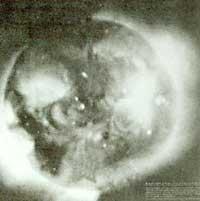Geminga: another name of the stranger
1987/02/01 Arregi Bengoa, Jesus Iturria: Elhuyar aldizkaria
Once again we will deal with some phenomena related to our Solar System. More precisely, we describe the current state of knowledge of two phenomena that scientists have tried to relate to in recent years. As we will see, no conclusive evidence of this relationship has been found so far, and research is waiting for new data to be collected. However, the debate does not lose interest, both because of the importance of the topics it refers to (the case of gravity waves predicted by the general theory of relativity), and because it is representative of how science advances in the fields of astronomy and astrophysics.
To respect the chronology of the discovery of phenomena, we will first talk about the lightning source discovered by the American satellite SAS-2 in 1972. Unfortunately, the SAS-2 sent only information about the existence of this source, about the cause of the breakdown it suffered at eight hours of its orbit around the Earth.

Scientists had no more information until Europeans sent the COS-B satellite in 1975. The scarcity of this type of emitters is not surprising, since being rays of great energy, its origin requires special processes. Two of the sources found, previously known and catalogued as pulse. The third was the same that the SAS-2 was released three years earlier.
This time the team of researchers analyzing the data sent by the COS-B satellite was responsible for naming the new object. Milanese astronomers proposed Geminga (contraction of Gemini and gamma), because the meaning of this word is nothing in its dialect. The reason for this condemnation lies in the lack of other personality data: although its position was not well limited, it was not possible to identify it with visible light emissions or from another spectrum band.
COS-B was receiving information for almost seven years, during which Geminga only emitted the beams of the rays mentioned in 5 monthly periods, at least in the direction of the Earth. Data scarcity does not allow great study possibilities, but attempts have been made to locate a period of the signal, analyzing the waves collected by Fourier transformation. The conclusions of these analyses give a period of 160 min to the Geminga signal. This value is exactly ninth part of the Earth's period of revolution, and some scientists thought that by this coincidence the phenomenon could be a consequence of Earth's rotation.
The next step was to clarify these last doubts. The different works carried out in this regard offer between 80 and 99% probability in favor of the signal being generated in Geminga. But alongside these there was another important and inexplicable problem: How far is Geminga?. This detail began to be resolved in the spring of 1981, when the Einstein satellite, launched to study X-ray sources, found a new emitter of this type of rays. Geminga was observed in the center of the region.
This extension also broke down shortly, but the information submitted gave two consequences: the first was the position of our star (195.1º of longitude and 4, 2nd of latitude with an error of 3'in each dimension) and the second the maximum distance limit. This limit was determined taking into account the lack of vulnerability observed in X-rays received by the satellite. Although the density of interstellar dust is very low, radiation always supports a small absorption, but as we said before, scientists did not find that defect in Geminga emissions and the only reason is closeness. Therefore, the maximum distance was set at 300 or 325 light years.
When this data was known, several scientists speculated on the hypothesis that Geminga could be the star friend of the Sun (about this problem we were dealt with in number 2 of the magazine). However, the data obtained in 1983 denied this possibility. This year a star of magnitude 21.2 was found in the first position of Geminga. Subsequently, the European satellite Exosat tried again to study X-rays and confirmed an absorption that was not found on other occasions at frequencies somewhat lower than those studied by the satellite Einstein.
This second observation leads us to assume that Geminga is in the vicinity of the maximum distance, while the first one places us before two adverse effects. On the one hand, the observations made with a telescope allowed us to measure the parallax of the star. As this was less than 0.2', Geminga's minimum distance was set at about 16 light years, confirming some lines as stated above. On the other hand, according to the color of the light, the star would be spectral type K and taking into account the particularities of a star typical of this group, Geminga should be about 48,000 light years to see it as seen.
So far we have tried to describe the first phenomenon. Let's analyze what you wanted to relate to this.
This second phenomenon was published in 1976, generating very intense debates in the scientific community. The reaction is not surprising, the phenomenon is really striking. The Sun suffers mechanical oscillations, that is, its surface rises and falls periodically, and its period is 160 min (!) is. How to rule out the temptation to relate both phenomena? As we have said, it was a very hard debate among the defenders of what the phenomenon was real and what was a consequence of the Earth's turn.
The different groups endeavored to make the measurements reaching the same conclusion. The last test was obtained by a group of French, who went to the South Pole and made measurements 24 hours a day in summer. Its period of obtaining was 160.01 min and taking into account the movement of the Earth with respect to the Sun, the effect Philieas Fogg leads us to a lower vibration. Given this correction, the period is equal to that of Geming. The amplitude of the oscillation is 1584 m.
The relationship between both phenomena would be found in the gravity waves that Geminga would generate simultaneously to the emission of rays.
When a body is at rest, it does not produce gravity waves, even if it has an empty spinning motion. The twist must have other secondary movements such as precesion or be a binary system. In addition, the moving masses must be very large (at the level of the masses of the stars) and their speed. Given these conditions, bracelets have been considered detectable stars that can generate gravity waves. Impulses are a consequence of the gravitational collapse suffered by some stars at the end of their lives.

The collapse causes the mass of the entire star to accumulate at a tenth or another kilometer at a very fast speed (hundreds revolutions per second), depending on the conservation of the angular momentum. Therefore, astrophysicists have considered the Geminga option as a pulse with precesion movement or a system formed by two pulsors. Thus, the vibration of the Sun is due to the action of gravity waves generated in Geminga.
Although no better hypothesis has been found so far, it also has some dark points. One is the highlight by researchers at the Meudon Observatory. This group calculated assuming that Geminga was a pair of pulses. According to the results obtained, the mass of the pair should be of the Sun 1000 times and be around the orbit of Pluto. Going back to the above, it is clear that Geminga is not at that distance. Another problem is that since the vibration period of the Sun has not been modified.
All the energy emissions of the bracelets are made at the expense of the energy of their movements. This means that the rotation of the pulses must be slower and slower, which would cause a change in the emission period. Specifically, in the case of gravity waves, the change of period would have given the same response to the vibrations of the Sun, but as we have said it has not been seen. Finally, and this must also be said, if Geminga is dotted, it would be the only one that would not broadcast radio waves.
This is the current situation of research. As we said at the beginning, there is no absolute evidence of the relationship between both phenomena, and there are those who say that relationship does not exist. Surely we will have no answer to receive different types of waves until the new satellites are put into orbit.

Gai honi buruzko eduki gehiago
Elhuyarrek garatutako teknologia





